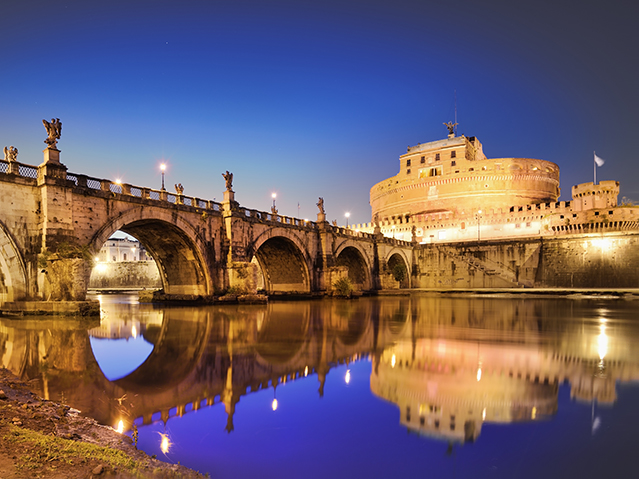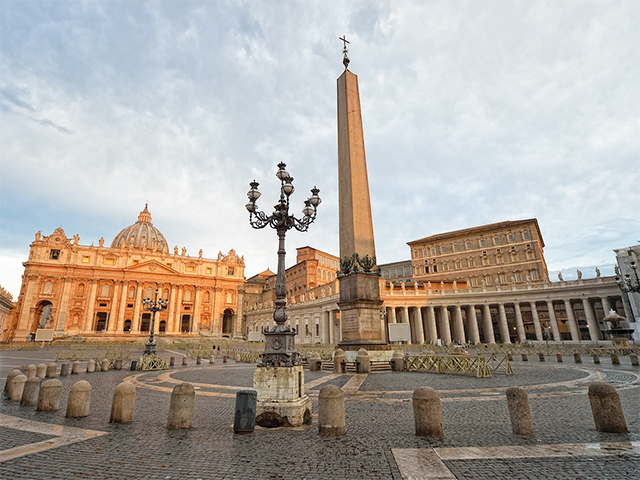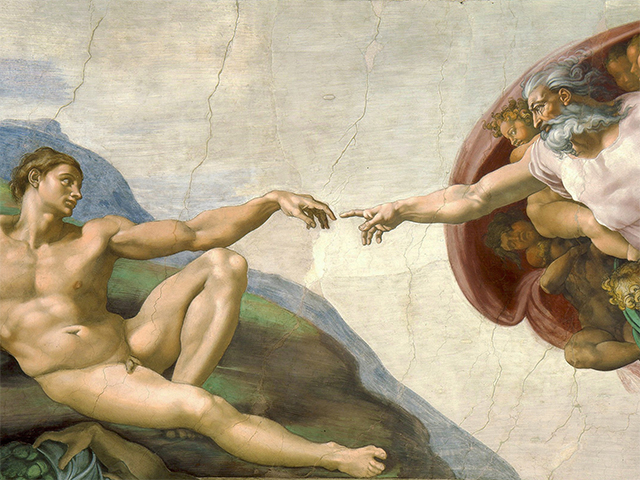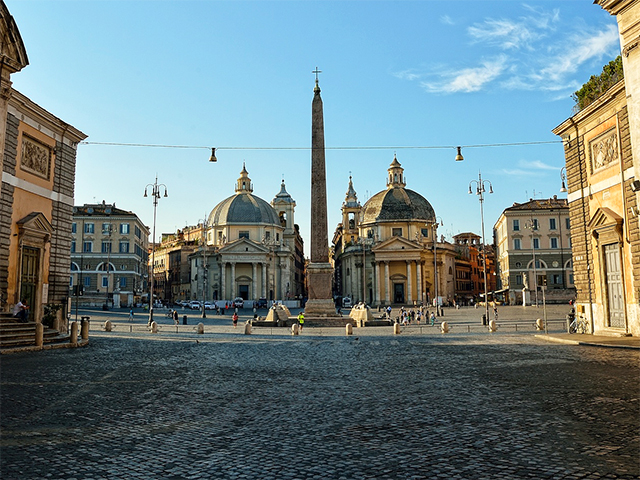Rome in 3 days: first day
First part of an itinerary visiting Rome in three days and experiencing an unforgettable weekend.LENGTH
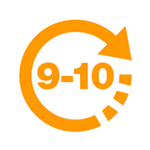
9-10 hours
Difficulty
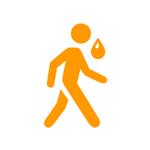
Medium
Budget

Low
Route stops
- Piazza del Popolo
Discovering Piazza del Popolo in Rome: how to get there, history, churches, the big obelisk and much more about one of the most famous squares in the world.
- Piazza di Spagna in Rome: how to get there and what to do
How to get there and what to do in Piazza di Spagna: history, monuments and pictures of one of Rome's most beautiful and elegant squares.
- Trevi Fountain
Trevi Fountain: location, how to get there, history, news and description of this romantic symbol of Italy in the world.
- The Pantheon of Rome
Everything about the wonderful Pantheon of Rome: history, architecture, description, opening hours and useful information about how to get there.
- Piazza Navona
Fom the Fountain of the four Rivers to the traditional Befana market: Piazza Navona is this and much more
- Campo dei Fiori Market
Campo dei Fiori in Rome: from folkloristic market in the heart of the historic centre to meeting point for nightlife.
Discovering Piazza del Popolo in Rome: how to get there, history, churches, the big obelisk and much more about one of the most famous squares in the world.
How to get there and what to do in Piazza di Spagna: history, monuments and pictures of one of Rome's most beautiful and elegant squares.
Trevi Fountain: location, how to get there, history, news and description of this romantic symbol of Italy in the world.
Everything about the wonderful Pantheon of Rome: history, architecture, description, opening hours and useful information about how to get there.
Fom the Fountain of the four Rivers to the traditional Befana market: Piazza Navona is this and much more
Campo dei Fiori in Rome: from folkloristic market in the heart of the historic centre to meeting point for nightlife.
1. Here we are, ready to start this itinerary to explore Rome. What time did you set your alarm clock? If you wish to see (almost) everything, we recommend to start early in the morning, but don't exaggerate... after all you are on holidays!
Our starting point is Piazza del Popolo, easily reachable by foot from the near subway stop Flaminio. This big square is the perfect place to start ourjourney into the discovery of Rome.
Entering thourgh the old Porta del Popolo (old Flaminia Gate) you will find yourselves surrounded by a big ellipse in the center of which stands the Flaminian Obelisk, one of the biggest obelisks in Rome. In the semi circles are the Fountain of Neptune and the Fountain of Goddess Roma, pointed one towards the other and the latest has the Pincio terrace in the back.

A panoramic view over Piazza del Popolo
On the north side of the square, we recommend you to visit the Church of Santa Maria del Popolo to admire masterpieces by Caravaggio like Conversion of Paul the Apostle and Crucifixion of St. Peter, many frescoes by Pinturicchio, the Assumption by Annibale Carracci, in additon to architectural works by Raphael Sanzio and Bramante and some sculptures by Andrea Bregno and Gian Lorenzo Bernini.
On the opposite side, instead, are the two twin churches of Santa Maria in Montesanto and Santa Maria dei Miracoli, constituting the two focus of the so-called trident, formed by Via del Babuino on the left, Via del Corso in the cente and Via di Ripetta on the right. Walking along Via del Babuino you will get to the second stop of this first day. Follow us!
In the meantime, if you want to know more about opening hours, prices and other things to see, read our in-depth article about Piazza del Popolo.
2. From Piazza del Popolo you can easily reach Piazza di Spagna walking along Via del Babuino in less than ten minutes. It is a pleasant walk among antique shops, boutiques and monuments of historic interest like the Church of Sant'Anasio and the fountain after which funny nickname "er babuino" the street has been named.
Without even realising, you will get to Piazza di Spagna, a favourite destination for tourists coming from all around the world, as well as Rome's cultural and tourist hub.
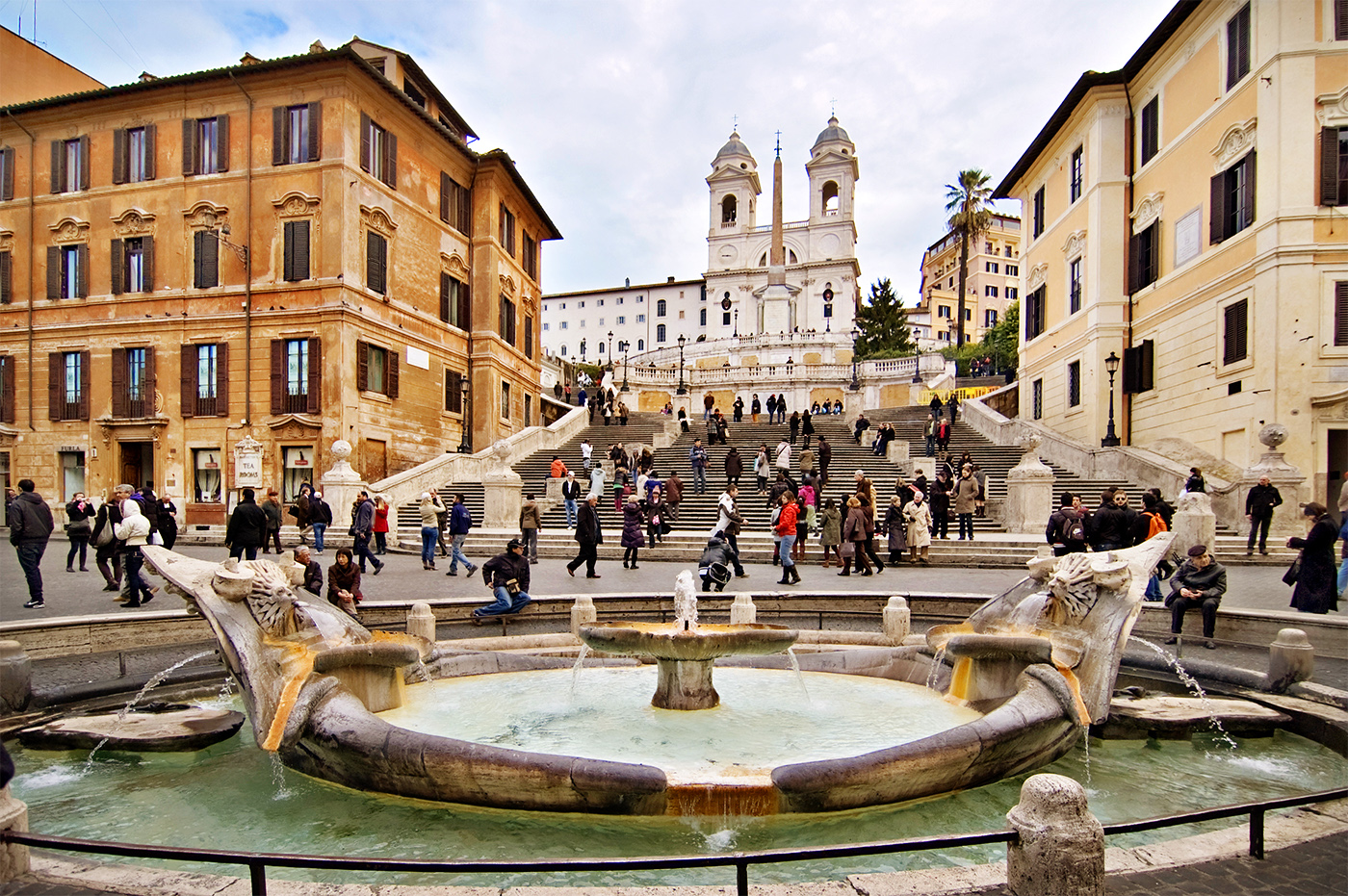
Piazza di Spagna
Frequented by artists and scholars since the sixteenth century, the square acquired its current appearance between the seventeenth and the eighteenth century. It's name is due to Palazzo di Spagna, seat of the Spanish Emabassy.
In the center of the square is placed the Barcaccia (Ugly Boat), one of Rome's most beautiful fountains, built by Pietro and Gian Lorenzo Bernini in 1627 by commission of Pope Urban VIII. At the feet of the Pincio Hill are the monumental steps, an emblem of the City.
Going up the 12 flights and 135 steps you will get to the Church of Trinità dei Monti with the Pincio terrace, from where you can enjoy a panoramica view over the city. In spring, the steps become even more beautiful, thanks to the traditional exhibition of Capitoline azaleas that are displayed all over the blooming period.
From Piazza di Spagna you can easily get to the famous Via Condotti, with its boutiques and luxury shops. This street rejoins also with Via del Corso, Roman shopping center par excellence. Don't worry about it now, you will have time to relax and go shopping during the third day of the itinerary.
Turn around to say goodbye to the square, and, from the adjacent Piazza Mignanelli where the famous Column of the Immaculate Conception can be found, enter Via di Propaganda and continue straight to get to the third stage.
3. In order to get to the Trevi Fountain, you will have to walk now about 15 minutes.
The route is very easy: always straight along Via di Propaganda and then along Via di Sant'Andrea Delle Fratte, until reaching Largo del Nazareno where you will enter, on your right into Via del Bufalo. Few meters ahead turn left in Via dei Poli. Go until the end of it, passing the crossing with Via del Tritone and you will get there!
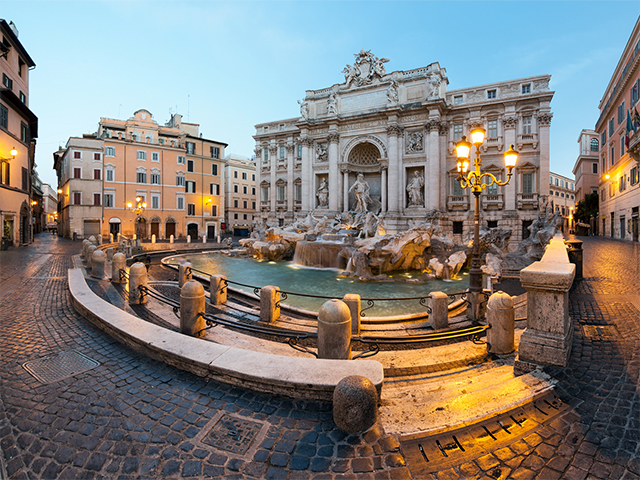
Trevi Fountain
The Trevi Fountain certainly needs no introduction!
This splendid fountain, well-known thanks to Fellini's Dolce Vita, is beyond doubt one of Rome's most visited spots.
Art, history and romanticism blend to create a simply unique work of art! The fountain is an architectural, cultural and engineering masterpiece.
The whole composition is focused on sea themes, dominated in the centre by the figure of Oceanus, on a shell-like carriage dragged by sea-horses and Tritons.
Every day tourists from all over the world mill around to admire it, to take some pictures as a souvenir and to toss a coin into the fountain, as established by tradition. Do you want to know why people toss coins into the Trevi Fountain? Read our article and your wishes will come true!
4. Now leave the fountain and go along Via delle Muratte, always packed with tourists and full of souvenir shops, bars and restaurants. Go until the end until the junction with Via del Corso and from the opposite side, continue in Via di Pietra. Along the street you will find Temple of Hadrian with its 11 Corintian columns made with white marble, showing you the way.
Not far away, in Piazza della Rotonda, there finally is the majestic Pantheon, great monument devoted to all the Roman gods. In fact, the name comes from the Greek words pan (all) and theon (god).
GUIDED TOUR OF THE PANTHEON
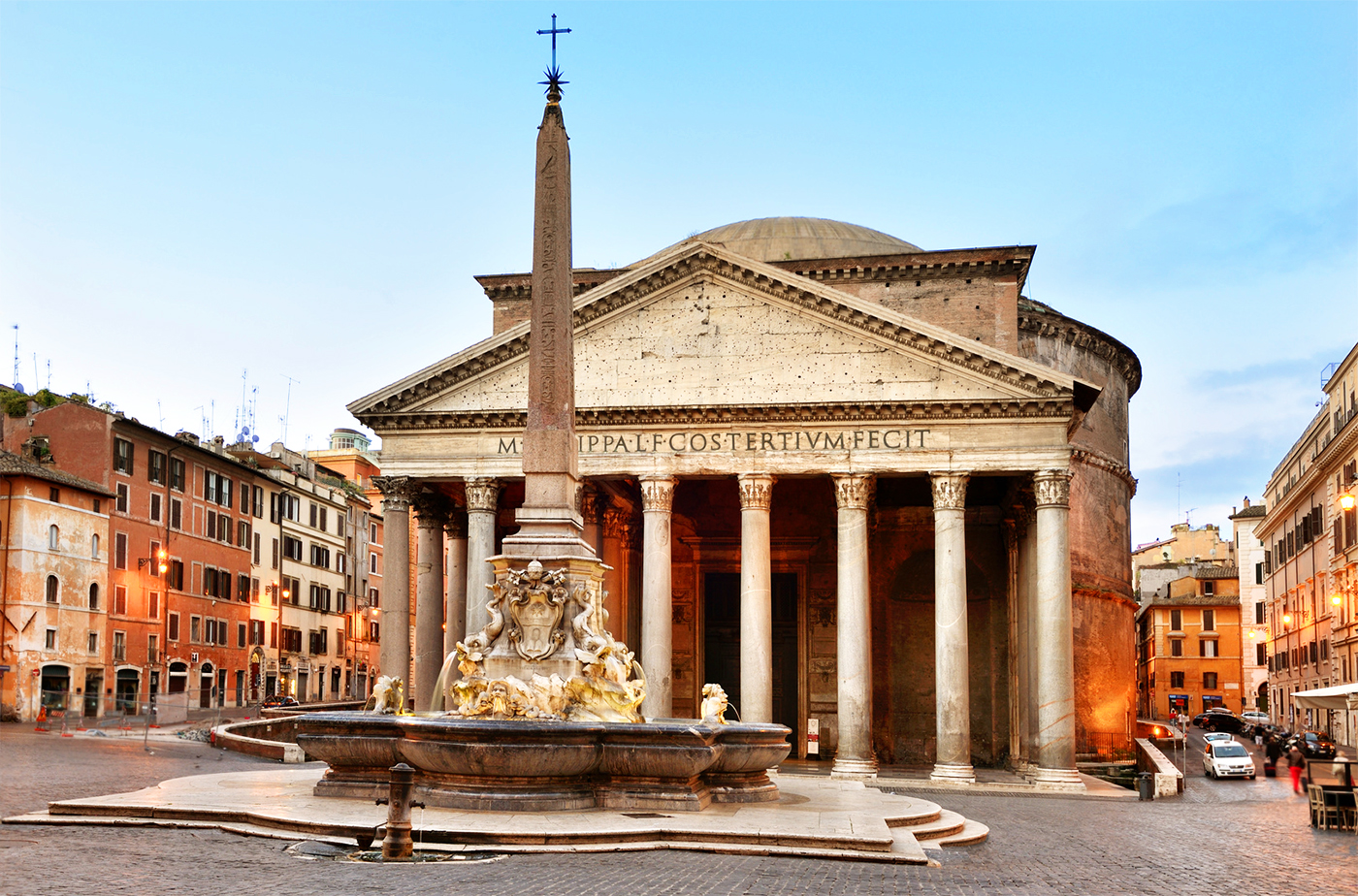
The Pantheon and the beautiful fountain in Piazza della Rotonda, designed by Giacomo Della Porta
Once you have passed the large columns and the giant main entrance made of bronze, an architectural wonder will unfold before your eyes. All of a sudden you will find yourself in this enormous empty space that will make you feel very little. So you need to feel in the presence of the gods!
The most interesting thing is that the diameter of the interior circle of the dome is exactly the same than the height. Ideally extending the arching of the dome, you get a perfect sphere! You will feel so surrounded by the dome that you will seem to be suspended in the core of a big empty sphere.
If you have followed our tips and have started the itinerary early in the morning, you will get in the Pantheon by noon, when the sunlight from the oculus is extraordinarily intense and it creates a really unique effect. See for yourself!
Is your stomach rumbling? As concentrated as you are on the wonders of Rome, you might not have realised that it is already lunch time!
This area, among restaurants and trattorias offers so many alternatives, but if you want to avoid falling into a trap for tourists we recommend you to move and look for a good quality-price compromise in the neighboring streets.
Anyway, keep in mind that you are in Rome's city center so if you want to save money, don't seat on a restaurant with views to the Pantheon but rather have a snack on the road or and alternative lunch eating, for instance, a gelato.

Rome: where to eat in the city center?
Close to Piazza di Montecitorio there is the historic Giolitti, one of the most famous and important gelaterias in the city.
Make your choice and bon appetite! After eating, stop for a short break at another great classic: the Caffè Sant'Eustachio. Placed in the square with the same name, very close to the Pantheon, it is considered to serve one of the best coffees in Rome.
5. Resume your route and from Piazza Della Rotonda, enter Via Giustiniani. At the junction with Via della Dogana Vecchia continue all along Via del Salvatore. Stop here in front of the very beautiful Church of St. Louis of the French, a real pearl set in the city center. Inside are kept absolute masterpieces by Caravaggio and guess what... admission is free!
Once outside, continue along the tiny Corsia Agonale at the end of which awaits Piazza Navona, one of Rome's most beautiful and important squares. With the famous Fountain of the four Rivers, the splendid Church of Sant'Agnese in Agone and the elegant Palazzo Pamphilj, the square is always heaving with street artists, paintes, tourists but also Romans.
Despite the wide impact of tourism, many come here to sit on benches, to eat a gelato or merely to have a chat in the bars and pubs that make the square come to life. Piazza Navona can, in fact, be considered the most loved square by Romans.
If you want to continue, read our article about Piazza Navona, with anecdotes, curiosities and useful information.

Piazza Navona
6. And here we are finally at the last unmissable stop of the day: Campo dei Fiori. This colourful market is probably the oldest in Rome. Since 1869, every morning, except on Sunday, the square is heaving with colourful stalls selling fruit, vegetables, meat, poultry and fresh fish.
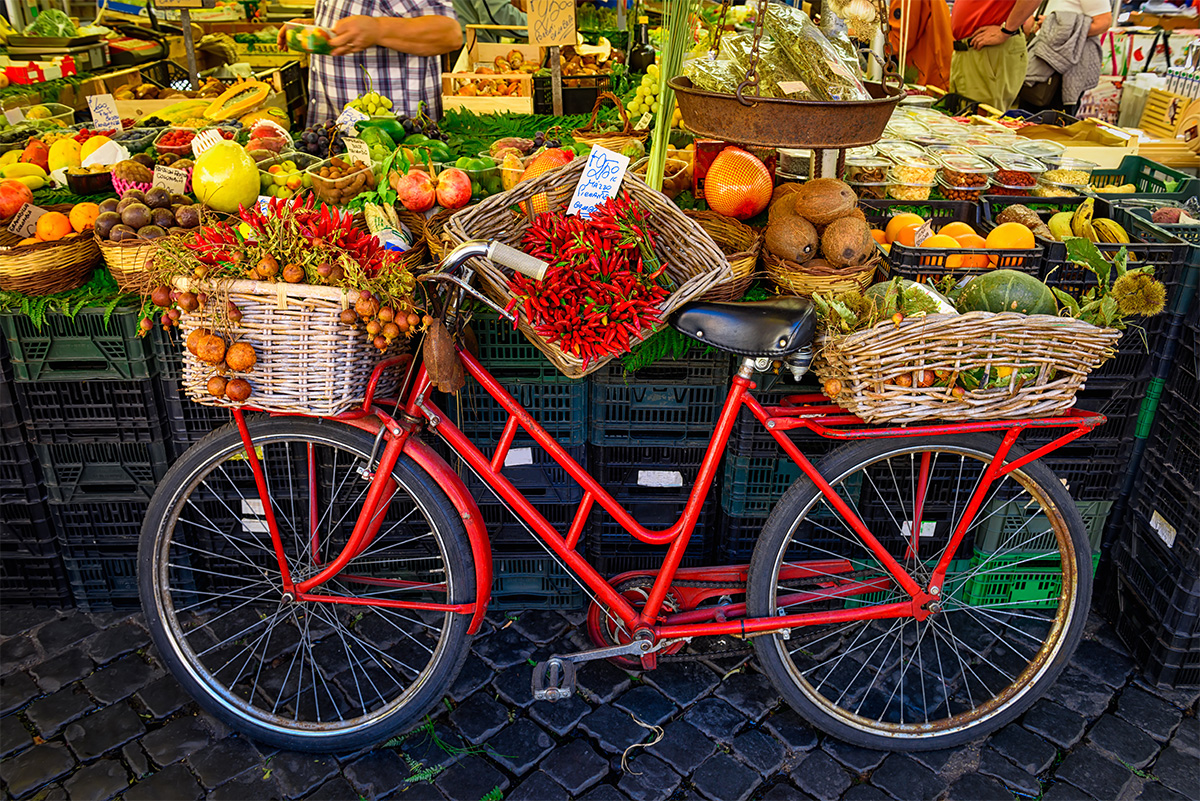
The Market of Campo dei Fiori
The market of Campo dei Fiori is a true feast for eyes and palate!
In the surroundings you will also find food shops, bakeries and much more! Campo dei Fiori is really the right place to buy Roman specialities or to get some food provisions to do a nice picnic outdoors.
Exploring the neighboring historic streets, you will find bars, restaurants and artisan workshops that still today bear the name of the Artisans who used to work there, like Via dei Baullari, Via dei Cappellari or Via dei Giubbonari. If you want to have a deep insight about the history of the square read here.
We have got to the end of the first day! Are you tired? As we said at the beginning, visiting Rome in three days is not an easy challenge, but it's not impossible either! Rest and get your strenght back because tomorrow you will see some great spots!
Now we recommend to go by walk to Largo di Torre Argentina and get bus 40 for 6 stops in order to get to Termini Station. From there, you will be able to get anywhere in the city by subway or by bus.
Click on the next day of the itinerary that you wish to read:



 PORT MOBILITY CIVITAVECCHIA
PORT MOBILITY CIVITAVECCHIA








